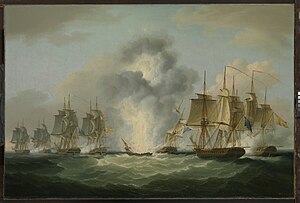Flotilla

A flotilla (from Spanish, meaning a small flota (fleet) of ships, and this from French flotte), or naval flotilla, is a formation of small warships that may be part of a larger fleet. A flotilla is usually composed of a homogeneous group of the same class of warship, such as frigates, destroyers, torpedo boats, submarines, gunboats, or minesweepers. Larger warships are grouped in squadrons.
A flotilla is usually commanded by a Rear Admiral, a Commodore or a Captain, depending on the importance of the command (a Vice Admiral would normally command a squadron). A flotilla is often divided into two or more divisions, each of which might be commanded by the most senior Commander. A flotilla is often, but not necessarily, a permanent formation.
In modern navies, flotillas have tended to become administrative units. As warships have grown larger, the term squadron has gradually replaced the term flotilla for formations of destroyers, frigates and submarines in many navies.
A naval flotilla has no direct equivalent on land, but is, perhaps, the rough equivalent in value of a brigade or regiment.
US Coast Guard
In the United States Coast Guard Auxiliary, a Flotilla is the basic organizational unit and consists of members at a local level where the majority of the work of the Auxiliary is done. A Flotilla is led by an elected Flotilla Commander assisted by an elected Vice Flotilla Commander, who is in turn assisted by appointed Flotilla Staff Officers.[1] A Coast Guard Auxiliary Division consists of multiple Flotillas and a District consists of multiple Divisions. Auxiliary Districts are organized along Coast Guard District lines and are administered by a Coast Guard officer (usually a Commander or Captain) who is called the Director of the Auxiliary.
Russian Navy
In the Russian Navy, the word flotilla has tended to be used for "brown-water" naval units - those operating not in the oceans and real seas, but in inland seas or rivers. Among the former are the present-day Caspian Flotilla, the early 20th century Satakundskaya Flotilla, or the Aral Flotilla of the 1850s;[2] among the latter, the Don Military Flotilla (which was created several times over more than 200 years), the Red Volga Flotilla, which participated in the Kazan Operation during Russian Civil War, or the Danube Military Flotilla. In the 18th century, the term also applied to the comparatively small fleets operating on those seas where Russia did not have much naval presence yet, e.g. the Okhotsk Flotilla.
Non-military Use
The word flotilla has been at times used to refer to a small fleet of vessels, commercial or otherwise.[3]. On May 31, 2010, the word flotilla became a Trending topic on twitter, in response to the Gaza flotilla raid,[4] in which Israeli commandos seized Turkish ships that were denied entry into Gaza.
See also
References
- Chief Director of Auxiliary (2007-02-15). "USCG G-PCX Web Site - Flotilla Organizational Structure". USCG Auxiliary Office of the Chief Director (CG-3PCX). Retrieved 2007-03-15.
- ^ As described at the Flotilla Organization page of the U.S. Coast Guard.
- ^ Ram Rahul. "March of Central Asia". Published 2000. Indus Publishing. ISBN 8173871094. p.160. On Google Books
- ^ http://www.ocscsailing.com/vacations/flotillas/index.php
- ^ "Did Twitter censor the #flotilla hashtag following the Israel attack?". The Guardian. 2010-05-31. Retrieved 2010-06-02.
